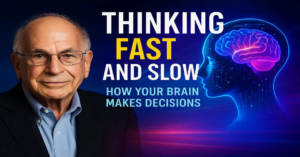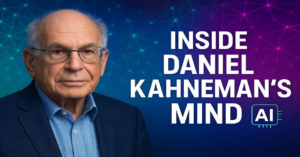Daniel Kahneman: Revolutionizing Human Decision-Making Through Psychology and Behavioral Economics
Beyond Intuition: How Daniel Kahneman “Thinking, Fast and Slow” Revolutionizes Decision-Making

“Our comforting conviction that the world makes sense rests on a secure foundation: our almost unlimited ability to ignore our ignorance.” — Daniel Kahneman
When psychologist and Nobel laureate Daniel Kahneman passed away in March 2024, he left behind a monumental legacy: a radical understanding of how human minds actually work. His 2011 masterpiece, Thinking, Fast and Slow, isn’t just a psychology book—it’s an operating manual for the human brain. Through decades of research, often with collaborator Amos Tversky, Kahneman dismantled the myth of human rationality and revealed a mind governed by two competing systems: one intuitive, the other analytical. This book has sold over 2.6 million copies and fundamentally reshaped fields from economics to medicine, yet its true power lies in how it transforms everyday decision-making.
Meet the Two Systems Inside Your Brain
Kahneman: The Autopilot
Speed and Nature: Operates automatically, intuitively, and effortlessly. When you jerk your hand from a hot stove, recognize anger in a facial expression, or complete the phrase “war and ____,” you’re using System 1. It handles approximately 95% of our daily decisions.
Evolutionary Role: Designed for survival. It detects threats (a slithering shape in the grass) and patterns (a child’s cry of pain) instantly. However, it’s prone to cognitive biases—jumping to conclusions based on limited information.
The WYSIATI Trap: “What You See Is All There Is” (WYSIATI) is System 1’s tendency to construct coherent stories from whatever information is available, ignoring critical gaps.
Example: Hearing “a shy, helpful man with a need for order,” most people guess “librarian” despite there being 20x more farmers—statistics fade before vivid stereotypes.
Daniel Kahneman : The Deliberate Controller
Effort and Logic: Engages in slow, effortful reasoning. Calculating 17×24, comparing insurance policies, or parking in a tight space requires System 2. It’s logical but lazy; it prefers endorsing System 1’s intuitions unless forced to intervene.
Cognitive Strain: When tired or overwhelmed, System 2 disengages. A study showed judges granting parole more often after lunch—depleted energy reduced their capacity for complex deliberation.
The Tug-of-War: Systems constantly interact. Driving a familiar route (System 1) shifts to System 2 when fog obscures the road. But System 2’s laziness creates vulnerability:
ease over truth. A statement in bold font feels truer than the same in light font simply because it’s easier to read.
Daniel kahneman : The Invisible Biases Sabotaging Your Choices
Kahneman exposed systematic errors (“biases“) hardwired into human cognition:
1. Anchoring: The Power of First Impressions
Effect: Initial numbers disproportionately sway decisions. In one experiment, subjects spun a wheel rigged to land on 10 or 65, then estimated African nations in the UN. Those seeing “10” guessed 25%; those seeing “65” guessed 45%.
Real-World Impact: Car dealers list high “sticker prices” to anchor negotiations. Salary offers set at $70,000 make $65,000 seem reasonable—even if the role’s market value is $60,000.
2. Availability: The Drama Bias
Heuristic: We judge likelihood by how easily examples come to mind. After a plane crash, people overestimate aviation risks; vivid media coverage amplifies this.
Terrorism vs. Diabetes: Though diabetes kills 200x more Americans than terrorism, fear resources skew toward the latter. Why? Vivid imagery trumps statistics.
3. Daniel Kahneman : Why Fear Outweighs Greed
Core Principle: Losing $100 hurts 2.5x more than gaining $100 pleases. This asymmetry shapes decisions:
Investing: People hold plummeting stocks to avoid “realizing” losses.
Sports: Golfers putt more accurately for par (avoiding bogey) than for birdie—fear drives precision.
Framing Effect: Surgery with a “90% survival rate” sees higher uptake than one with a “10% mortality rate“—identical outcomes, opposite reactions.
4. The Planning Fallacy: Optimism’s Costly Delusion
Definition: Underestimating time, costs, and risks. Kitchen remodels planned for $18,658 balloon to $38,769 on average; 90% of drivers believe they’re “above average“.
Root Cause: System 1’s focus on ideal scenarios (“inside view“) while ignoring base rates (“outside view“). Sydney’s Opera House finished 10 years late and 1,400% over budget.
Daniel Kahneman : Transforming Theory into Real-World Wisdom

A. Debunking Expertise: When Intuition Fails
Valid Intuition: Chess masters instantly spot winning moves after 10,000+ hours of pattern recognition. In stable environments (firefighting, nursing), trained intuition excels.
Danger Zones: In unpredictable realms (stock markets, politics), experts often underperform algorithms. Psychologist Philip Tetlock found pundits’ predictions worse than chance.
Solution: Replace intuition with simple algorithms. A study showed formulas outperforming clinical judgments in diagnosing heart attacks. When stakes are high, objectivity beats “gut feel”.
B. Daniel Kahneman : Clash of Experience vs. Memory
Experiencing Self: Lives in the present—the pain of a headache, the joy of sunshine.
Remembering Self: Constructs narratives prioritizing peaks and endings. Example: A colonoscopy’s prolonged mild discomfort is remembered as less painful than a shorter but sharper one if it ends gently.
Implication: We sacrifice happiness (e.g., working a hated job for years) to serve the remembering self’s desire for a “meaningful story.” Recognizing this split helps align decisions with actual well-being.
C. Daniel Kahneman Tools for Smarter Decisions
- Premortems: Before launching a project, imagine it failed. List why—legitimizes doubts and surfaces overlooked risks.
- Broad Framing: Evaluate decisions in aggregate. Instead of agonizing over a single stock loss, review your portfolio’s annual performance.
- Ugly Fonts for Important Docs: Printing contracts in hard-to-read fonts forces System 2 engagement, reducing oversight.
- Check Your Anchors: Before negotiations, consciously set your own anchor based on data—not the other party’s opening bid.
- Defaults and Nudges: Opt-out systems (e.g., automatic retirement savings) leverage
Daniel kahneman : Critiques and Enduring Legacy
Replication Challenges and Refinements
Some priming studies cited (e.g., “Florida effect” linking elderly words to slower walking) faced scrutiny during psychology’s replication crisis. Critics argue effects are smaller than initially claimed.
The “two systems” model is debated as overly simplistic. Neuroscientists note brain functions are distributed, not binary—yet the framework remains invaluable for explaining behavioral patterns.
Why Daniel Work Endures
Unlike abstract theories, Kahneman’s insights are actionable:
- A CEO might combat loss aversion by rewarding calculated risks.
- Doctors counter availability bias by using diagnostic checklists.
- You might pause before overpaying for an extended warranty, asking: “Is this loss aversion talking?“
“The illusion that we understand the past fosters overconfidence in our ability to predict the future.” — Kahneman
His greatest gift was humility. By mapping our cognitive flaws, he freed us from the delusion of perfect rationality. In a world demanding ever-faster decisions, Thinking, Fast and Slow remains a vital call to sometimes—critically—slow down.
Kahneman’s work underpins “nudge units” in governments worldwide and behavioral finance. His book isn’t just about thinking—it’s about relearning how to be human in an irrational world.